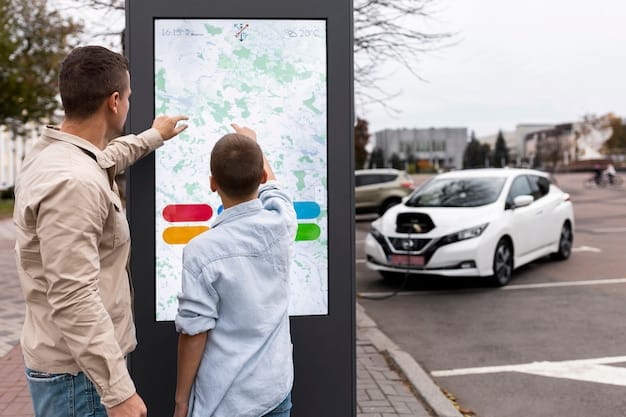Ride-Sharing Impact: Analyzing Car Ownership Trends in the US

Analyzing the impact of ride-sharing services’ increasing popularity on car ownership in the US reveals a complex interplay of convenience, cost, and evolving consumer preferences, potentially leading to a shift away from traditional car ownership.
The rise of ride-sharing services has undeniably transformed urban transportation in the United States. But is this convenience impacting a deeply ingrained aspect of American culture: car ownership? This article delves into analyzing the impact of the increasing popularity of ride-sharing services on car ownership in the US, exploring the multifaceted factors at play.
The Ascent of Ride-Sharing: A Transportation Revolution
Ride-sharing platforms such as Uber and Lyft have experienced explosive growth in recent years, reshaping how people move within cities. This section explores the factors contributing to their success and widespread adoption.
Convenience and Accessibility
Ride-sharing offers unparalleled convenience. With a few taps on a smartphone, users can summon a ride from virtually anywhere, at any time. This accessibility is particularly appealing in urban areas with limited parking and robust public transportation alternatives.
Cost-Effectiveness
For many, ride-sharing presents a cost-effective alternative to owning and maintaining a car. Instead of incurring expenses like insurance, registration, maintenance, and fuel, users only pay for the rides they need.
- Ride-sharing eliminates the financial burden of car ownership for occasional users.
- Users avoid parking fees and the hassle of finding parking spaces.
- Ride-sharing costs are often lower than taxis, making it an attractive option.
In conclusion, ride-sharing’s ascent is driven by its superior convenience, accessibility, and often lower costs compared to traditional car ownership, especially for those who use transportation sporadically.
Economic Considerations: Car Ownership vs. Ride-Sharing
The decision between owning a car and relying on ride-sharing services often boils down to economics. This section dissects the financial implications of both options.

The True Cost of Car Ownership
Beyond the initial purchase price, car ownership entails a multitude of ongoing expenses. These include insurance premiums, routine maintenance, unexpected repairs, fuel costs, and depreciation. When these factors are considered, the total cost of ownership can be substantial.
Ride-Sharing as a Variable Expense
Ride-sharing, conversely, is a variable expense. Users only pay for the rides they take, making it easier to budget and control transportation costs. This is particularly advantageous for individuals with unpredictable travel needs.
- Ride-sharing offers predictable, per-ride costs, simplifying budgeting.
- Users avoid the depreciation costs associated with car ownership.
- Costs can be optimized for specific needs, switching between modes as required.
In summary, the economic considerations hinge on usage patterns; frequent drivers might still benefit from owning a car, while occasional users often find ride-sharing more economically viable.
Urbanization and Changing Lifestyles
The increasing concentration of populations in urban centers, coupled with evolving lifestyles, is further fueling the shift toward ride-sharing.
The Appeal to Urban Dwellers
Urban areas often offer robust public transportation options, making car ownership less essential. Ride-sharing seamlessly complements public transit, providing a convenient last-mile solution.
Shifting Preferences and Priorities
Younger generations, in particular, are exhibiting changing attitudes toward car ownership. They prioritize experiences and convenience over material possessions, which aligns well with the on-demand nature of ride-sharing.
- Ride-sharing facilitates a car-free lifestyle, appealing to environmentally conscious individuals.
- Younger generations value flexibility and access over ownership.
- Urban living often involves limited parking and increased traffic congestion, making ride-sharing a more attractive option.
Ultimately, urbanization and changing lifestyles, especially among younger demographics, are contributing to the appeal and increased adoption of ride-sharing services.
Environmental Impact: Ride-Sharing vs. Personal Vehicles
The environmental implications of ride-sharing are complex and debated. This section examines the potential benefits and drawbacks.

Potential for Reduced Emissions
Ride-sharing has the potential to reduce overall emissions by optimizing vehicle occupancy and reducing the number of cars on the road. When multiple passengers share a ride, the per-person emissions decrease.
Concerns about Increased Congestion
However, some studies suggest that ride-sharing may contribute to increased congestion, especially in densely populated areas. The increased number of ride-sharing vehicles on the road can offset any potential emission reductions.
In conclusion, the environmental impact of ride-sharing depends on factors like vehicle occupancy, route optimization, and the overall impact on traffic congestion. Further research is needed to fully understand the long-term effects.
The Role of Public Transportation
Ride-sharing isn’t necessarily a replacement for public transit but often serves as a complementary mode of transportation, affecting car ownership decisions.
Filling the Gaps in Public Transit
In areas with limited or unreliable public transportation, ride-sharing provides a crucial link, connecting people to jobs, services, and amenities. This accessibility can reduce the perceived need for personal car ownership.
Integration with Public Transit Systems
Some cities actively integrate ride-sharing into their public transit systems, offering incentives for riders to use ride-sharing for the first and last miles of their journeys. This integration further strengthens the appeal of a car-free lifestyle.
- Ride-sharing extends the reach of public transit, making it more convenient and accessible.
- Integrated systems can offer cost savings for both riders adn the city.
- Partnerships between governments and ride-sharing companies are the best solution.
To summarize, ride-sharing often complements public transportation, filling gaps and providing last-mile connectivity, potentially reducing the need for car ownership, especially when transit systems are integrated with these services.
Future Projections and Industry Trends
The future of transportation is likely to be shaped by continued innovation and evolving consumer preferences. This section explores potential trends and projections for the ride-sharing industry and its impact on car ownership.
Autonomous Vehicles and Electric Fleets
The advent of autonomous vehicles and the transition to electric fleets could further disrupt the transportation landscape. Autonomous ride-sharing services could offer even greater convenience and affordability, while electric vehicles would address environmental concerns.
Subscription Services and Mobility-as-a-Service (MaaS)
Subscription services and Mobility-as-a-Service (MaaS) platforms are gaining traction, offering users access to a range of transportation options for a fixed monthly fee. These models could further reduce the appeal of car ownership.
- Autonomous vehicles promise reduced costs and increased availability of ride-sharing.
- Electric fleets could mitigate environmental concerns associated with transportation.
- Subscription services provide access to multiple transportation options, reducing the need for car ownership.
In essence, future projections indicate that continued technological advancements and innovative service models will further challenge the traditional notion of car ownership in the US.
| Key Aspect | Brief Description |
|---|---|
| 🚗 Car Ownership | High upfront and maintenance costs; offers independence and convenience. |
| 📱 Ride-Sharing | Lower per-use cost; convenient and accessible via apps. |
| 🏙️ Urbanization | Ride-sharing thrives in urban areas with limited parking, complementing public transit. |
| 🌱 Environmental Concerns | Potential for reduced emissions via optimized occupancy in ride-sharing. |
FAQ
▼
Not necessarily. If you frequently drive long distances, owning a car might be more economical. Ride-sharing savings are typically realized by those who use it sparingly or for short trips.
▼
The impact is mixed. While it can reduce the total number of vehicles on the road if people share rides, the increased ease of access can also lead to more frequent trips and potential congestion.
▼
Like any form of transportation, ride-sharing has inherent risks. However, companies implement background checks and tracking features to enhance safety. Always verify the driver and vehicle before entering.
▼
MaaS is a subscription-based model offering unified access to various transportation modes (public transit, ride-sharing, bike sharing) under a single platform and payment system. It aims to simplify urban mobility.
▼
Autonomous vehicles are expected to drastically reduce the cost of ride-sharing, making it even more accessible and convenient. This could accelerate the shift away from personal car ownership.
Conclusion
In conclusion, analyzing the impact of the increasing popularity of ride-sharing services on car ownership in the US reveals a complex and evolving landscape. While ride-sharing offers convenience, cost savings, and environmental benefits, the decision to forgo car ownership depends on individual needs, lifestyle, and location. As technology advances and transportation options diversify, the future of mobility in the US is likely to be increasingly shaped by shared and on-demand services.





